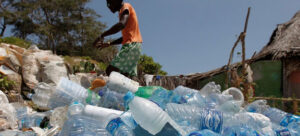
Africa, Civil Society, Development & Aid, Economy & Trade, Featured, Headlines, Sustainable Development Goals, TerraViva United Nations

A congested street in Bulawayo where public transporters pick up passengers at an undesignated point. Credit: Ignatius Banda/IPS
– As the population in African cities grows, governments are struggling to provide sustainable public transport solutions, conditions that have led to gridlock in major business districts.
Projections show rapid growth of urban populations across the continent, and town planners are hard-pressed for time on how new spaces and infrastructure will be created for efficient public transport.
A growing number of cities are expected to hit a population of more than 10 million people by 2035, but social services are failing to match the overload on existing infrastructure, with public transport being one of the major sticking points.
In countries such as Zimbabwe, where government-owned transport utilities have been overtaken by thousands of illegal taxi operators, local authorities are fighting an uphill battle to bring order out of the urban chaos.
In the country’s two major cities, Harare and Bulawayo, municipalities have put in place measures to decongest the public transport sector, but these have fallen flat as both registered and unregistered operators have routinely ignored the decrees to work from designated points.
For example, in 2015, the city of Bulawayo awarded a multimillion-dollar contract for the construction of what was hoped to be a futuristic public transport terminus, but operators have shunned it, claiming its positioning in the central business district is bad for business.
While the Egodini Mall Taxi Rank and Informal Traders Market was also expected to provide trading space for vendors in anticipation of business from travelers, it is marked by empty vending bays, with traders preferring crowded CBD sidewalks instead.
City mayor David Coltart has conceded that the project risks becoming a white elephant, and construction of the next phase of the project has been halted to deal with these challenges, highlighting the challenge growing cities face in their efforts to modernise amenities.
Zimbabwe’s public transport headaches come against the backdrop of the Second World Sustainable Transport Day this November, where policymakers and agencies rethink urban mobility.
Other pertinent issues include ways of incorporating public transport into the broader improvement of “safety and security, reducing pollution and CO2 emissions while increasing the attractiveness of urban environments,” according to a United Nations Economic Commission for Africa (UNECA) briefing during the 2023 World Sustainable Transport Day.
According to UN Habitat, the day was declared by the UN General Assembly “in recognition of the important role of safe, affordable, accessible, and sustainable transport systems for all in supporting sustainable economic growth, improving the social welfare of people, and enhancing international cooperation and trade among countries.”
However, to achieve this, UNECA says African governments must put in place “remedial measures” that will ensure the continent’s transportation systems are more sustainable and environmentally friendly.
“African governments must prioritize inclusive urban planning,” said Atkeyelsh Persson, chief of the Urbanization and Development Section at the Economic Commission for Africa.
“Key areas of focus should include upgrading infrastructure such as roads and utilities,” Persson told IPS.
This comes as Zimbabwe and other regional countries seem to be going backwards in realising UNECA’s goals as they are struggling to cope with rapid urbanisation and provide sustainable urban transport solutions for city dwellers.
During last year’s inaugural World Sustainable Transport Day, UNECA said the continent was in urgent need of developing sustainable and resilient public transport infrastructure if Africa is to “optimise the development of interconnected highways, railways, waterways, and airways.”
The agency noted that Africa’s rapid urbanisation was also a call to escalate sustainable urban transport solutions, but with government cuts in public spending and also the drying up of private investors in the sector, public transportation has only deteriorated.
“Despite this growth in urban populations, the rate of growth in housing, infrastructure, and basic amenities has not kept pace with this urban growth,” said Nyovani Madise, a demographics professor and President of the Union for African Population Studies.
“This has resulted in mushrooming of urban informal settlements, waste and pollution, congestion on the roads and overcrowding,” Madise told IPS.
While UNECA has called for the optimisation of interconnected transportation, Zimbabwe’s once thriving railways has become virtually nonexistent, with the National Railways suspending its passenger train service citing operational challenges.
As part of desperate efforts to deal with the shrinking space for public transport, the Bulawayo municipality is planning to take over parking space at the National Railways of Zimbabwe train station for use as a long-distance bus terminus.
The unusual move was triggered by an increasing number of long-distance buses in Bulawayo who have joined smaller pirate taxis picking up passengers in undesignated points.
These developments have further highlighted the difficulties some African countries face in balancing urban population growth and public transport needs, which could be a missed opportunity towards UNECA’s proposed “socially inclusive, environmentally sustainable, and well-governed continent.”
IPS UN Bureau Report












